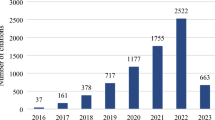Summary
The most common method for genetic evaluation when parents are unknown is best linear unbiased prediction with genetic groups (BLUP-G). With this method unknown parents are assumed to be unrelated to any other animals in the population. This assumption is unrealistic in most situations. If a finite number of potential parents can be identified and the probabilities of being the true parent can be assigned to these, genetic evaluation can be obtained given the uncertainty of parentage without introducing genetic groups into the model. The correct numerator relationship matrix with uncertain parentage (Ā) is derived. Rules are given to efficiently compute Ā and Ā-1. Computer simulation was used to compare BLUP-G with BLUP using Ā. The simulated population consisted of ten sires and 200 dams per breeding season. The dams were always known; the sires were unknown for 10% or 30% of the males and 30% of the females. The number of potential sires was three (BLUP-Ā1 or ten (BLUP-Ā2), including the true sire in both cases. Equal probabilities were assigned to each potential sire. The increase in response with BLUP-Ā1 and BLUP-Ā2 relative to BLUP-G ranged from 4% to 8% in the fifth breeding season. Selection with BLUP-Ā1 or BLUP-Ā2 resulted in higher inbreeding, 17% and 12%, respectively, than with BLUP-G. Estimates of response to selection were unbiased with BLUP-Ā1 and BLUP-Ā2, but not unbiased with BLUP-G. Mean square error of estimated genetic means and mean prediction error variance were higher with BLUP-G than with blup-Ā1 or BLUP-Ā2.
Similar content being viewed by others
References
Chang, HL, Fernando RL, Grossman M (1991) On the principle underlying the tabular method to compute coancestry. Theor Appl Genet 81:233–238
Dempfle L (1990) Problems in the use of the relationship matrix in animal breeding. In: Gianola D, Hammond K (eds) Advances in statistical methods for genetic improvement of live-stock. Springer, Berlin Heidelberg New York, pp 454–473
Falconer DS (1989) Introduction to quantitative genetics, 3rd edn. Longman, New York
Fernando RL, Gianola D (1986) Optimal properties of the conditional mean as a selection criterion. Theor Appl Genet 72:822–825
Foulley JL, Gianola D, Planchenault D (1987) Sire evaluation with uncertain paternity. Genet Sel Evol 19:83–102
Henderson CR (1973) Sire evaluation and genetic trends. In: Proc Anim Breed Genet Symp in Honor of Dr Jay L Lush. Am Soc Anim Sci Am Dairy Sci Assoc, Champaign, Ill., pp 10–41
Henderson CR (1976) A simple method for computing the inverse of a numerator relationship matrix used in prediction of breeding values. Biometrics 32: 69–83
Henderson CR (1988) Use of an average relationship for multiple-sire joining. J Anim Sci 66:1614–1621
Misztal I, Gianola D (1987) Indirect solution of mixed model equations. J Dairy Sci 70:716–723
Quaas RL (1988) Additive genetic model with groups and relationships. J Dairy Sci 71:1338–1345
Poivey JP, Eisen JM (1984) Estimation de la valeur génétique des reproducteurs dans le cas d'incertitude sur les apparentements. I. Formulation des indices de sélection. Genet Sel Evol 16:445–454
Robertson A (1961) Inbreeding in artificial selection programmes. Genet Res 2:189–194
Sorensen D, Kennedy BW (1984) Estimation of response to selection using least-squares methods and mixed model methodology. J Anim Sci 58:1097–1106
Van Vleck LD (1970) Misidentification in estimating the paternal sib correlation. J Dairy Sci 53:1469–1474
Westell RA, Quaas RL, Van Vleck LD (1988) Genetic groups in an animal model. J Dairy Sci 71:1310–1318
Wiggans GR, Misztal I, Van Vleck LD (1988) Animal model evaluation for Ayshire milk yield with all lactations, herd-sire interaction, and groups based on unknown parents. J Dairy Sci 71:1319–1329
Author information
Authors and Affiliations
Additional information
Communicated by L. D. van Vleck
Rights and permissions
About this article
Cite this article
Perez-Enciso, M., Fernando, R.L. Genetic evaluation with uncertain parentage: a comparison of methods. Theoret. Appl. Genetics 84, 173–179 (1992). https://doi.org/10.1007/BF00223997
Received:
Accepted:
Issue Date:
DOI: https://doi.org/10.1007/BF00223997




